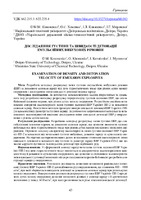Показати скорочений опис матеріалу
Examination of density and detonation velocity of emulsion explosives
| dc.contributor.author | Kononenko, M. | |
| dc.contributor.author | Khomenko, O. | |
| dc.contributor.author | Kovalenko, I. | |
| dc.contributor.author | Myronova, I. | |
| dc.date.accessioned | 2022-05-17T05:53:51Z | |
| dc.date.available | 2022-05-17T05:53:51Z | |
| dc.date.issued | 2022 | |
| dc.identifier.uri | http://ir.nmu.org.ua/handle/123456789/160382 | |
| dc.description.abstract | Purpose. To develop a method for calculating the change in the density of emulsion explosives (EE) along the length of the charge column under the action of hydrostatic pressure at different angles of inclination of the boreholes and to examine the change in the detonation velocity along the charge. The methodology of research. Using the well-known laws of hydrostatics and ideal gas, the method for calculating the redistribution of the density of bulk explosives, which are sensitized by gas pores, at different boreholes inclination angles has been developed. Empirical regularities of changes in the density of the bulk EE Ukrainit-PP-2 along the length of the charge column were established by regression analysis. The rheostat method was used to measure the detonation velocity of the EE Ukrainit-PP-2 depending on the diameter and density of the charge. With the help of the proposed methodology and the established regularities, an examination of the change in the detonation velocity in boreholes with different inclination angles has been performed. Findings. The method for calculating the change in the density of explosives sensitized by gas pores along the length of the charge column, which makes it possible to determine the density of explosives under the action of hydrostatic pressure at different angles of inclination of ascending and descending boreholes has been developed. A general quadratic regularity was obtained for the change in the density of the bulk EE Ukrainit-PP-2, depending on the initial density of the explosive, the length of the charge, and the angle of inclination of the borehole. On the basis of experimental data, power-law patterns of change in the detonation velocity depending on the density and diameter of the Ukrainit-PP-2 explosive charge were established, which makes it possible to control the density and velocity of detonation during ore breaking. The originality. In the formed charge column, the initial density of the bulk EE Ukrainit-PP-2 under the influence of hydrostatic pressure changes according to a quadratic pattern depending on its length and the angle of inclination of the borehole, which makes it possible to determine the location of the priming cartridges and develop designs of charges in boreholes by the power-law pattern of change in the detonation velocity. Practical implications. The results of the research allowed to establish a rational initial density of EE Ukrainit-PP-2 for breaking ores by the boreholes, which is 800–1000 kg/cu.m, at which the detonation velocity is maintained along the length of the charge column at different angles of inclination of the boreholes. The application of the results of calculating the density of EE Ukrainit-PP-2 at different angles of inclination of the boreholes makes it possible to determine areas in the charge column with its critical values of more than 1410 kg/cu.m, at which a sharp attenuation of the detonation velocity begins. Accounting for this negative phenomenon allows to prevent the occurrence of failures during the explosion of charges in boreholes during ore breaking. | uk_UA |
| dc.language.iso | uk | uk_UA |
| dc.subject | emulsion explosives | uk_UA |
| dc.subject | density | uk_UA |
| dc.subject | detonation velocity | uk_UA |
| dc.subject | charge length | uk_UA |
| dc.subject | borehole | uk_UA |
| dc.title | Examination of density and detonation velocity of emulsion explosives | uk_UA |
| dc.type | Article | uk_UA |
| dc.identifier.udk | 662.215.3: 622.235.4 | uk_UA |

